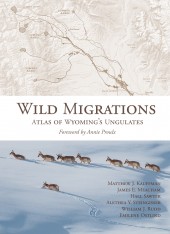Pennsylvania whitetails, like the state’s human residents, are homebodies. Fun fact: 74% of Pennsylvania residents were born in state. Only Louisiana (79%), Michigan (77%) and Ohio (75%) have more native residents.
Sure, 75% of Pennsylvania male deer disperse as yearlings, but they only average about 5 miles. Every now and then there is an overachieving yearling that travels 20+ miles before settling down in an adult home range but that is hardly the norm.
Fewer yearling females disperse (9-32%). But when they do, they make it worth their while by traveling further (32 miles) before finding a place to call home.
Once Pennsylvania deer settle into their adult home range, they rarely leave. That’s why the rare exceptions are such anomalies.
Deer in Pennsylvania just don’t like to travel. At least compared to their western cousins. Compared to Pennsylvania whitetails, western ungulates are gypsies.
And a new book shares the state-of-the-science about the landscapes of Wyoming and how large ungulates travel through it over time.
Wild Migrations: Atlas of Wyoming’s Ungulates is a collaboration of scientists and cartographers telling the story of animal movement in Wyoming.
Wyoming has plethora of ungulates – elk, mule deer, moose, bighorn sheep, pronghorn, white-tailed deer, and bison – and all exhibit migratory behavior. Our favorite ungulate, the white-tailed deer, is the least migratory of the bunch – they average 5-10 miles with some covering up to 40 miles and only 25-50% of Wyoming white-tailed deer migrate at all.
Then there is the Wyoming mule deer, the whitetail’s high strung and complicated cousin. Some individuals annually migrate 150 miles between their summer and winter range. Yet some mule deer might not migrate at all – sometimes in the same herd! I told you they were complicated.
Why all the variation? Because variety is the spice of life – and evolution. If future conditions change, some behaviors may be rewarded while others may not. The reward is successfully passing on genes to offspring. Having that variation in the population will increase the odds that a species will persist.
This book is also about the challenges faced by these animals in a changing landscape. Wyoming landscapes are negatively transforming for these ungulate species. Energy development, roads, a changing climate, and fences are affecting these large mammals and the news is rarely good.
But not all is gloom and doom. The book chronicles how government agencies responsible for managing these species are addressing these challenges. By asking a seemingly simple question (how and when animals move across the landscape), Wild Migrations opens the flood gates of the huge implications for protecting species and the wild places upon which they depend.
These stories have shrunk our perception of the size of many of our public lands. Consider Yellowstone National Park, for example, the second largest national park in the continental US. One of our greatest national parks covers 3,468 square miles, yet the area over which the elk that summer in Yellowstone move is probably upwards of 20,000 square miles!
If you thought managing white-tailed deer in Pennsylvania was fraught with controversy and challenges, consider what Wyoming is facing with 7 species that travel tens to hundreds of miles on an annual basis.
Wild Migrations is a beautiful book with data translated into images on almost every page. If you’ve ever visited or hunted – or plan to visit or hunt – in Wyoming, you’ll want to read this book.
Maybe Santa’s globetrotting ungulates can get it to you in time for the holiday.
-Duane Diefenbach and Jeannine Fleegle
If you are interested in purchasing a copy of Wild Migrations, you can order it here. Check it out!
If you would like to receive email alerts of new blog posts, subscribe here.
And Follow us on Twitter @WTDresearch
